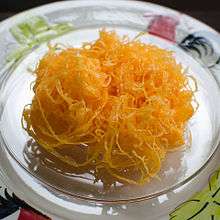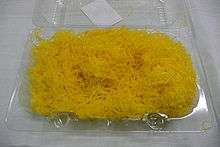Fios de ovos
Angel hair, called in Portuguese Fios de ovos ("egg threads") is a traditional Portuguese sweet food made of eggs (chiefly yolks), drawn into thin strands and boiled in sugar syrup. They are a traditional element in Portuguese and Brazilian cuisine, both in desserts and as side dishes (only in Brazil).
 Foi thong in Thailand | |
| Alternative names | Angel hair |
|---|---|
| Type | Dessert |
| Place of origin | Portugal |
| Main ingredients | Eggs (chiefly yolks), sugar syrup |
The preparation is also known in Spain as Huevo hilado ("spun egg"), in Japan as Keiran Somen (鶏卵素麺, "hen's egg noodle"),[1] in Cambodia as Vawee,[2] in Malaysia as Jala mas ("golden net"),[3] and in Thailand as Foi Thong (ฝอยทอง; "golden strands").[4] In North Malabar Region of Kerala,India it is known as Muttamala (മുട്ടമാല; "egg strands").[5]
History

Like other egg-based Portuguese sweets, fios de ovos is believed to have been created by Portuguese nuns around the 14th or 15th centuries. Laundry was a common service performed by convents and monasteries, and their use of egg whites for "starching" clothes created a large surplus of yolks.[6] The recipe was probably taken to Japan and Thailand by Portuguese explorers between the 16th and 18th centuries.
Thailand
Fios de ovos is called Foi Thong in Thailand. The name of the dessert comes from the observation that it has fine, long stripes and is shiny like silk. It is considered a fine dessert. The word Thong (gold) has an auspicious connotation to Thai people. The long stripe is also seen as symbolizing a long life and undying love.[7] Fios de ovos was introduced from Portugal to Thailand by Maria Guyomar de Pinha, sometimes considered the Queen of Thai desserts.[8] It is served as a dessert in propitious ceremonies.[9]
Japan
Keiran Somen is the name of Fios De Ovos in Japan, where it was first made 342 years ago. The restaurant Matsuyariemon has produced their traditional signature Keiran Somen for 13 generations. The dessert is one of the nanbangashi, which are desserts introduced from Portugal in the Nanban trade, and the recipe has been an exhaustively guarded secret passed down from one generation to the next.
This Keiran Somen was cut into bite-sized pieces and wrapped with a line of seaweed, called Keiran Somen Tabane. The 12th generation leader of Matsuyariemon came up with the concept of the simple-to-eat dessert and beautiful form perfect for chanoyu (tea ceremony). Keiran Somen Tabane is an elegant sweet that is sure to make a good gift.[10]
Uses
In Portugal and Brazil, fios-de-ovos are often used in fillings, decorations of cakes and other desserts and accompaniments for sweet dishes. In Brazil, they are also used as accompaniments in savory dishes, often served with canned fruits alongside Christmas turkey.[11][12] In Japan, they are served in the form of dessert rolls (wagashi), and known as keiran sōmen (鶏卵素麺, egg yolk thin noodles).[1]
See also
- Egg garnish
- Papo de anjo
- Quindim
- Thong yip
- List of Brazilian sweets and desserts
References
- Kyoto Foodie, Wagashi: Angel Hair Keiran Somen (Fios de Ovos). Accessed on July 7, 2009.
- Longteine De Monteiro (1998). The Elephant Walk Cookbook: Cambodian Cuisine from the Nationally Acclaimed Restaurant. Houghton Mifflin.
- It's sweet by any name, . Accessed on May 05, 2014
- Bangkok Post Educational Services, "Three tempting Thai delicacies". Accessed on October 29, 2011.
- Muttamala Recipe, "" Accessed on September 12, 2017
- Marina Alves (2008), Dos deuses. Online article, Jornal da Pampulha, Belo Horizonte, accessed on July 5, 2009.
- Wandee Na- Songkhla (2012). Legendary thai dishes in three eras.. Accessed on September 14, 2016.
- Thai Desserts, "Thai Food and Culture" Archived 2013-11-13 at the Wayback Machine. Accessed on September 14, 2016.
- Foy Thong (Gold Egg Yolks Thread), "Thai Cuisine Recipe". Accessed on February 18, 2007.
- Travelers’ Treasures , "Matsuyariemon Keiran Somen Tabane". Accessed on September 16, 2016.
- Porto Cultura, "Peru de Natal". Accessed on July 8, 2009.
- Terra Culinária, "Peru de Natal" Archived 2008-12-21 at the Wayback Machine. Accessed on July 7, 2009.